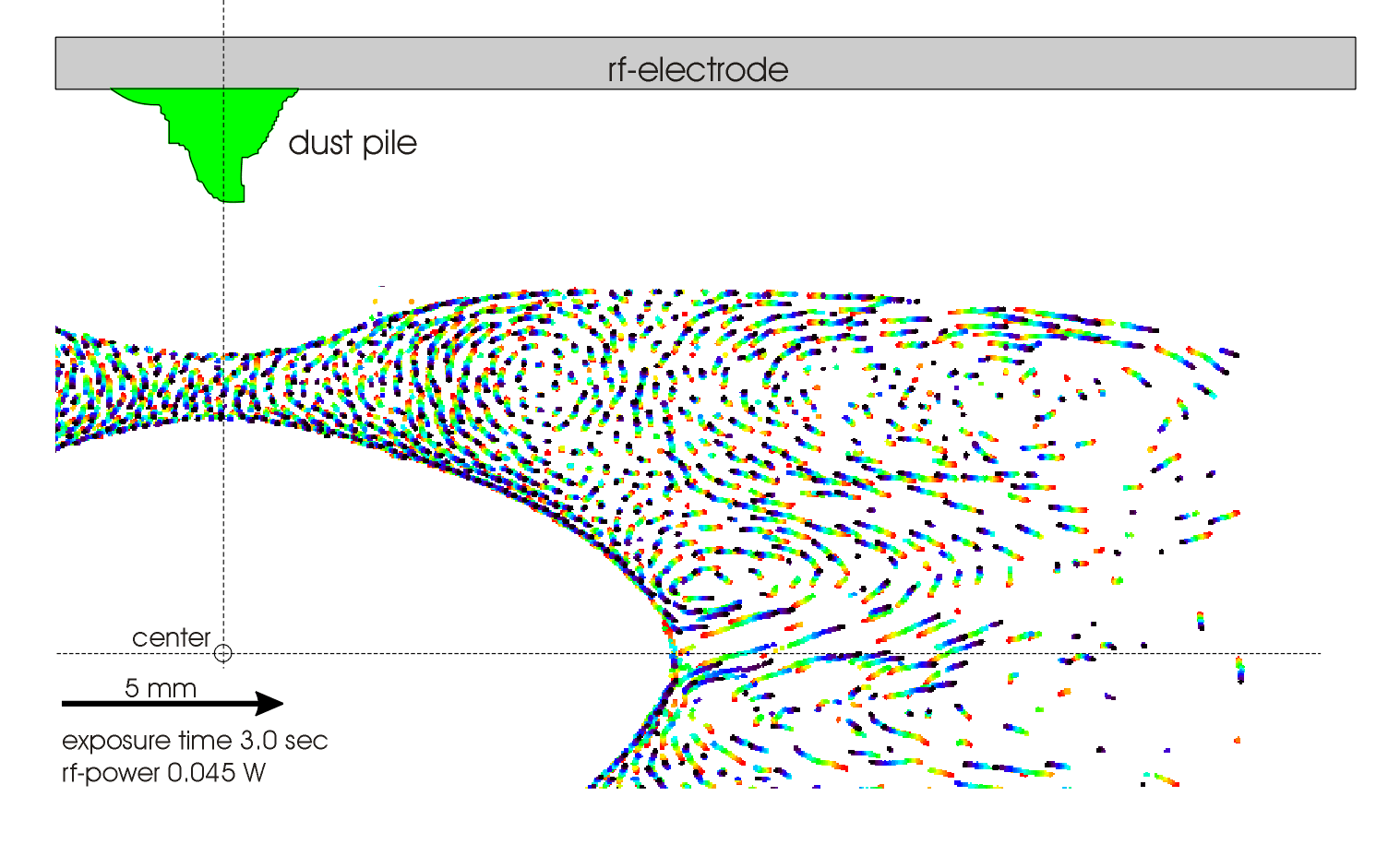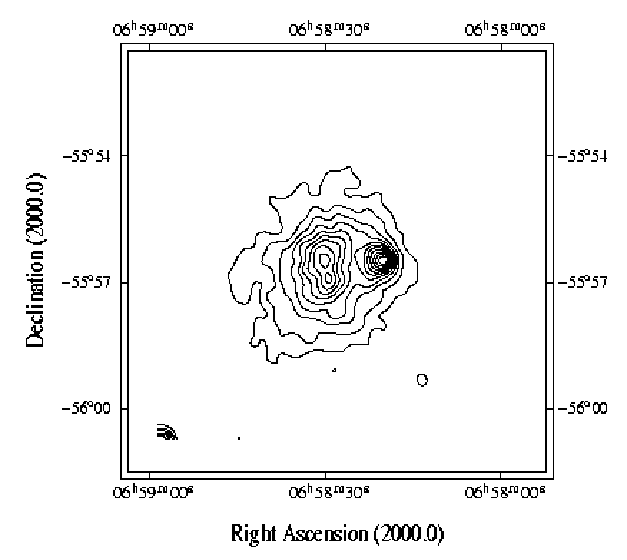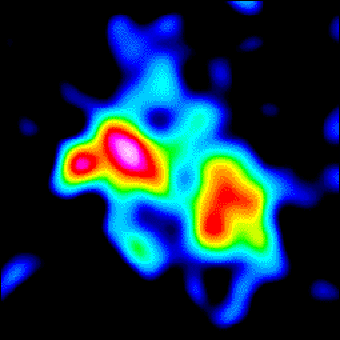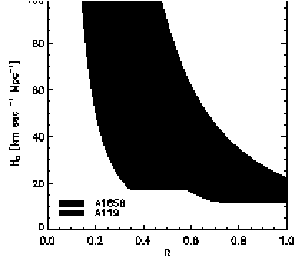Theory-Group
Annual Report 1997
Astrophysical Plasmas
Work on Astrophysical Plasmas included theoretical investigations of diffusion caused by collective processes, different aspects of magnetic reconnection, and the solution of dispersion relations for plasma waves for general distribution functions.
Astrophysical and cosmical plasmas are mostly collisionless. The diffusion of particles is then goverened by collective processes. Observations show that particles may be subject to Levy flight dynamics. In this case particles remain for an unusually long time near a scattering center and then suddenly suffer large displacements. Modelling of the probability distribution for the displacement leads to a k-distribution. The corresponding diffusion coefficient is time dependent. This process may be of importance at the magnetopauses of the Earth and other planets. One makes either in situ or remote observations of the direct entry of plasma from the external environment across a magnetopause into a magnetosphere. Under collisionless conditions a strongly enhanced diffusivity is required whenever reconnection can be excluded.
Magnetic reconnection is a fundamental process which is essential for transport of matter across a magnetic field. The process was investigated analytically in the framework of incompressible magnetohydrodynamics. It was shown with a boundary layer analysis that one can obtain solutions of the resistive MHD equations which describe fast reconnection. In this way a long standing discrepancy between results from numerical simulations and earlier simple analytical models was resolved in a rather satisfying manner. Since in one-fluid MHD the kinetic effects of the ions are neglected we have used a so-called hybrid code in order to investigate magnetic reconnection. Here, the ions are treated as individual particles and the electrons are represented as a charge-neutralizing massless background fluid. It was found that when kinetic effects are included, the global structure of the reconnecting fields differ considerably from those obtained in MHD simulations. The mathematical description of boundary layer problems was generalized with the help of methods from differential geometry. Although particle simulations mostly start with a combination of Maxwellian distributions, it is found that these distributions rapidly become strongly non-Maxwellian. Through this effect alone, waves cannot only be stabilized, as described by quasilinear theory, but also other wave modes may go unstable. In order to analyse these dynamics, a numerical code for the solution of dispersion relations for arbitrary distribution functions was developed. Experimentally obtained distributions can be specified in the calculations.
Plasma Crystals
Plasma Crystals constitute a special form of colloidal plasmas, i.e. plasmas containing micron-sized particles (i.e. dust particles). We performed experiments in the laboratory, built equipment which we used to conduct experiments under zero gravity conditions and developed the accompanying theoretical framework.
In the laboratory we studied wave propagation through a plasma crystal. The measured results were compared with theoretical predictions. The investigation of the oscillation amplitudes of such systems shows that the friction in plasma crystals is due primarily to interaction between particles and neutral gas. For excitation frequencies above 1 – 2 Hz there is good agreement between the theoretically and experimentally derived dispersion relations. For lower excitation frequencies we find from the experimental results a larger dissipation rate than predicted by theory. The difference can be attributed to the finite size of the plasma crystal.
The rocket-borne experiment of November 1996 showed several very interesting phenomena. These included a paucity of particles in the central region between the electrodes (Fig. 2.42), a poloidal circulation of the total particle cloud and a relaxation of the particle cloud after the plasma was shut off. Different models were considered in order to explain the results. The calculations show that the electrostatic interaction of the dust particles with the large-scale electric field (averaged over one rf period), the electrostatic interaction between dust particles, and frictional forces between dust particles and neutrals do not cause these interesting dust dynamics. Thus, the dynamic behaviour of the dust must be dominated by effects not taken into account in present calculations; these include friction between ions and dust particles. In 1997 we also performed experiments on a plane flying on parabolic trajectories. The plane flights were used to test an improved experimental design to be flown on the second sounding rocket flight, which is scheduled for February 1998. The most significant modifications since the first experiments are the inclusion of two synoptical video channels and new mechanics for the dust dispenser giving better leakage and higher efficiency and the use of smaller particles (7 µm instead of 15 µm) as well as techniques allowing the regulation of the plasma power by telemetry and telecommand lines.
Laboratory experiments for plasma crystals in strong magnetic fields with field strengths of the order of 1 Tesla are planned. In such a high magnetic field the gyro radii of the ions can become comparable with distances between the particles in the lattice. This could open up a new area in the physics of strongly coupled magnetized plasmas. Calculations are presently being performed in order to derive the collisional cross sections of ions and electrons with a dust particle in a strong magnetic field and the equilibrium charge of a dust particle resulting from ion and electron absorption.
The fractional ionization as a function of visual extinction was calculated for a range of number densities that typify extended clumps in giant molecular clouds and the more compact dense cores in which star formation occurs. The strong dependence of fractional ionization on visual extinction near a value of 2.5 suggests the existence of a critical visual extinction (of that value) above which turbulence is damped rapidly by ion-neutral friction and can play no role in clump support. The chemical evolution of gas collapsing at the center of a clump initially having about the critical visual extinction was followed. The existence or absence of peaks in the abundances of "early-time" molecules (the presence in high abundances of which has traditionally been believed to indicate dynamical youth) depends sensitively on the assumed dependence of visual extinction on density during collapse. Together with complementary studies showing that depletion onto dust grains in dynamically old regions can cause high abundances of some "early-time" molecules, these investigations indicate that the problem of the chemical dating of star forming cores is even more subtle than had been believed.


Fig. 2.42: Here, the trajectories of the particles are shown colour coded (red at the beginning of the trajectory and violet at its end) for different exposure times and plasma parameters. The field of view is 20 x 25 mm2 . The exposure times/rf-power for the different figures are 3 sec/0.045W (upper) and 1 sec/0.12W (lower).
In order to model recent ISO observations of photodissociation regions (PDR's) detailed numerical codes were further developed for the solution of equations governing the chemical and thermal balances in those irradiated surfaces of molecular clouds. To gain a clearer understanding of the complex structures of such regions, a very simple description was also developed to adequately model the chemical, ionization, and dissociation balances in PDR's with the few dominant reactions. This approach revealed the important role that chemical dissociation of H by ionized carbon and atomic oxygen plays in warm PDR's: the carbon ionization and hydrogen dissociation balances are intricately coupled at temperatures above 400 K. It was also realized how significant an effect the still poorly determined H formation rate coefficient has on the PDR structure; it may, in fact, be possible from recent spectroscopic observations to constrain this most important reaction rate coefficient.
Star Formation
Analysis of observations of young stars and theoretical investigations are performed.The analysis of the large scale distribution of young stars that were found in the ROSAT all-sky survey to be especially X-ray luminous is beginning to establish a new, exciting picture of the stellar population in the solar neighbourhood. In addition to the population expected from standard models of stellar distributions we find evidence for another component of nearby, late-type, young stars. The trigonometric parallaxes obtained with the astrometry-satellite HIPPARCOS allowed us to reconstruct their three dimensional spatial distribution and showed that these stars are distributed rather uniformly in a plane defined by the Gould Belt. Groundbased spectroscopy of the lithium absorption line confirmed their youth. A major fraction of the widespread population of X-ray active stars in the solar neighbourhood discovered with ROSAT can most likely be identified with hitherto unknown low-mass members of the Gould Belt with ages between 30 and 70 Mio years.
The origin of some especially young stars found far outside classical star forming regions is rather mysterious. We investigated consequences of the hypothesis that these stars could have been ejected from multi-body systems by close encounters early in their evolution. Their high velocities and characteristic directions should allow us to infer the original times and positions of the encounters. We identified P1724 in Orion as a probable RATTS (run-away T-Tauri star) ejected from the Trapezium system some hundred thousand years ago.
In this context we investigated the influence of strong tidal forces on the structures of circumstellar disks: close encounters in multiple stellar systems are expected to lead to an observable rearrangement of disk material, provided the periastron distance is of the order of the disk radius. Numerical simulations of a highly eccentric double star system were carried out over three orbital periods of the binary. The primary was surrounded initially by an unperturbed accretion disk. We studied the dependence on the inclination angle between disk and orbital planes of the rearrangement of angular momentum and disk material. The formation of a disk around the secondary is a frequent outcome. Sometimes the formation of a gravitationally bound, transient companion, reminiscent of a giant planet occurs.
We continued investigations of gravitational instabilities in massive protostellar disks, using both linear analyses and nonlinear hydrodynamic simulations. The star/disk systems studied are fully three-dimensional, and both the star and the star/disk interface play an active role in the dynamics. Instabilities take the form of multi-armed spiral disturbances, which may disrupt the disk for strong cooling, possibly forming substellar companions close to the young star. Studies of mass transport mechanisms in planetary rings due to meteoroid impacts and of chondrule formation mechanisms are also being pursued (e.g. electrostatic discharges in the presolar nebula).
Studies of Galaxy Clusters
Astrophysical and cosmological studies of galaxy clusters resulted in the following: The frequency with which substructure or mergers are observed in clusters of galaxies reflects the growth of large-scale structure in the Universe. Model simulations and theoretical calculations show that the frequency of substructure is an interesting observable measure of the mean density of the Universe. The substructure can be best observed in X-ray emission; in particular, studies with the ROSAT observatory are extending our insight significantly. Therefore we investigated how the substructure as observed in X-ray images can be quantified for a comparison with models. The analysis results in a mass estimate for the major component responsible for the observable substructure. The results for a sample of clusters can be compared with model calculations. We showed that the frequent detection of substructure does not necessarily imply a high density Universe, as was generally assumed earlier, but is more consistent with a Universe with a mean density of 0.2 to 0.3 of the critical value.
For the X-ray luminous cluster, RX J0658-5557, discovered in the southern part of the ROSAT Sky Atlas, we obtained deep ASCA observations. An intracluster plasma temperature of 13 keV, the second highest measured to date, was inferred. We found a Sunyaev-Zel'dovich increment and decrement at 1.2 and 2 mm, respectively, with the ESO SEST telescope. The combination of the millimeter and X-ray observations yields the absolute distance to this galaxy cluster and a value for the Hubble constant. A Hubble constant of 58 km s-1 Mpc -1 was implied by the more reliable 2 mm decrement while a nominal value of 12 km s-1 Mpc-1 was found for the increment. The latter result is more difficult to extract due to various contaminating effects. This was only the second time that such an increment has been observed at all. The modelling of the SZ effect is complicated further by the fact that this cluster is observed to be in the course of a cluster merger, as shown in Fig. 2.43.


Fig. 2.43: ROSAT HRI image of the cluster RX J0658-5557, for which the Sunyeav-Zel'dovich effect was observed. The merger of two subcomponents is clearly seen.
Fig. 2.44: ROSAT/HRI image of the optically richest cluster Cl0939+4713. The cluster shows pronounced substructure: two subclusters which show even some internal structure - an indication of a young cluster still being far away from virial equilibrium.
The galaxy cluster with the largest richness number (highest galaxy number) in the Abell catalogue Cl0939+4713 (Abell 851) was observed with the ROSAT/HRI, -/PSPC, and with ASCA. The cluster consists of two main components, which also show internal substructure (Fig. 2.44). Even though the cluster appears so prominent in the optical with its high number of galaxies, it has a surprisingly low X-ray luminosity of (0.1-2.4 keV) erg/s and a very small metal abundance of ~ 0.2 in solar units. Together with the large galaxy number of this cluster the metal abundance provides interesting constraints on the enrichment models for the intracluster medium.
The comparison of the ROSAT HRI and PSPC observations which are separated by a 5 year interval shows a variable X-ray source - probably an active galaxy - whose X-ray luminosity varied by more than an order of magnitude within this period.

Fig. 2.45: The domain of possible values of the cosmological mass-ratio W and the Hubble constant H determined from the CHDM model for the clusters A1656 (Coma) and A119.
Investigating the mass distribution in Clusters of Galaxies may provide information about the cosmologically relevant mass. The accepted cosmological model of the Dark Matter in the Universe is the mixed model of matter. This model is known under the name CHDM model (Cold-and-Hot-Dark-Matter-model). This model apparently agrees best with the measurements of the matter distribution in the Universe and numerical N-particle simulations of this distribution. It contains enough free parameters to fit the power spectra of the matter distribution in the Universe as determined from optical observations at different red shifts. The mixed matter model implies a hot component which is identified with massive neutrino matter and is super-imposed on an unknown massive cold Dark Matter component. Particle physics suggests that the effective mass of the neutrinos involved amounts to 2.45 eV. If this model reflects the real conditions one demands that the matter accumulated in clusters of galaxies, the largest compounds of matter in the Universe, should as well consist of both Dark Matter components. In order to test this assumption one refers to X-ray measurements. It is emitted by the baryonic component of the intra-cluster medium which serves as a tracer of the intra-cluster potential. To this end a mixed matter cluster model has been developed. In equilibrium the Dark Matter in the cluster satisfies the predictions of Violent Relaxation. The CHDM model has been applied to Coma (A1656) and A119, the two most relaxed clusters known. The model reproduces quite well the X-ray emission as measured by ROSAT of the intra-cluster gas and therefore seems to be realistic. However, it does not resolve the excess-baryon problem as is known from other cluster models. For acceptable values of the Hubble constant the baryonic fraction of matter is far more than 5%. It thus exceeds the permitted value known from nucleo-synthesis for a flat Universe (Fig. 2.45). On the other hand, the baryonic fraction can be used to restrict the cosmological density parameter W . The figure shows that for both clusters the CHDM model is in conflict with the assumption of a flat Universe. This supports the suggestion that the Universe deviates from flat geometry.
Radio-Loud Active Galactic Nuclei
Radio-loud active galactic nuclei are the most luminous objects in the Universe. One of the topics of modern astrophysics is the study of the physical processes close to the massive central nucleus of these objects, their different observational manifestations as well as their cosmic evolution. From the large data base obtained by correlating the ROSAT data with radio surveys we studied individual, particularly interesting individual objects with other X-ray instruments (ASCA, BeppoSAX) to utilize their wider energy band and their higher energy resolution. Some of the objects showed presently unknown or unobserved properties which have to be explored with future X-ray instruments with higher sensitivity and which await a theoretical interpretation. Further on, the available ROSAT data have been correlated with the recently available very sensitive VLA radio surveys (FIRST, NVSS). The large number of several thousand new radio- X- ray sources will allow to study objects in the so far unexplored transition region between radio-loud and radio-quiet active galactic nuclei.
Complex Dynamics
In the field of complex dynamics we focus on developing and testing quantitative methods for analysing spatially and/or temporally complex systems. The application of the methods is not restricted to astrophysical systems.
We have developed a technique to distinguish between the presence of a nonlinearity in a given time series and the existence of a noisy linear process mimicing a nonlinearity. To do so, we used a method that characterizes time series by their nonlinear predictability. The method can discriminate non-linear, noisy data sets from surrogates. The latter have the same amplitude spectrum and autocorrelation function as the data, but the underlying process is linear and random. The predictability is expected to be close to 1 for deterministic and close to 0 for stochastic systems. The entire system is then globally characterized by the weighted mean of all its predictabilities. We used the technique to identify the one noisy raw data set amongst a group of 9 surrogates with a 99% success rate which compares favourably to the 87% sucess rate obtained by the application of the frequently used nonlinear prediction error method.
In image processing applications, the classification and segmentation of complex structures (so-called textures) frequently play important roles. The texture features can be quantified with the use of anisotropic scaling indices and local statistical values. In this way a feature vector is assigned to each pixel (Fig. 2.46). This type of image segmentation will be applied in medicine to improve the quantitative tumor diagnostic. The first calculations with single tissue slices yielded promising results.
The studies in the field of medicine and physiology aim at the refinement of medical diagnostic methods through the application of new techniques of image and time series analysis which have been developed at the MPE.
The complexity analysis of the fetal ECG during birth for the
assessment of the fetal condition and prediction of the fetal outcome has been extended to
the prenatal state. In most cases a fetal distress can be predicted with these measures
earlier than with conventional methods.
In addition, a dermatoscopic workplace has been developed with outside collaborators to
make a computer based determination of the so-called dermatoscopic ABCD-scores. With this
device a very high recognition rate of the malignant melanomas has been achieved. The
image analysis techniques can be used for the general assessment of (biological) tissue.
These and other new methods for tumour diagnosis and therapy monitoring will soon be in
operation.

Fig. 2.46: An image with five natural textures (left). Segmentation of the image in five classes using anisotropic scaling indices (right).
The development of a computer model simulating the electrical activity of the human heart by a cellular automata (CA) is of particular use for cardiology. The rules of the CA are derived from a realistic microscopic model (taken from the literature) of the electrical activity of single cardiac cells. Based on the electrical state of the about 90000 model cells (configured according to the geometry of a real heart) the potential at the surface of a model torso, and hence the ECG, are calculated. Effects of antiarrhythmic drugs on the ECG can be discovered through the introduction of a slight modification of the microscopic model.
Our research has been supported by DARA/DLR (50.WM.9445.6, 50.TT.9527.9 and (50.TT.9731.0). We have received support from the Verbundforschung (05.3ME82A(7), 05.3ME62.(0) and 50.OR.9306.5). The biosignal project have been supported by the B-W-Stiftung.
Updated: 2007-10-12
Contact: Michael Kretschmer